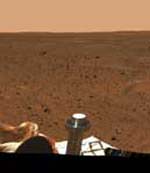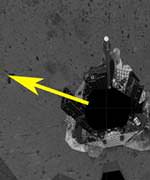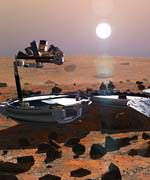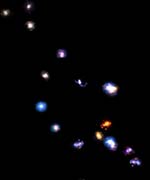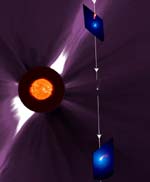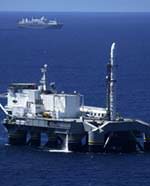
Image credit: Boeing
Sea Launch successfully launched the Telstar 14/ Estrela do Sul 1 communications satellite into orbit over the weekend. The Zenit 3SL rocket lifted off from the floating Sea Launch platform on January 10 at 0413 UTC (11:13 pm EST January 11), and the dual satellite separated from the upper stage shortly after that. The satellite will provide television, data, and communication services to the Americas and the North Atlantic Ocean.
Sea Launch Company successfully deployed Loral?s Telstar 14/Estrela do Sul 1 communications satellite into orbit tonight. All systems aboard the Space Systems/Loral 1300-series spacecraft are reported in excellent condition.
The Sea Launch Zenit-3SL rocket lifted off at 8:13 pm PDT (4:13 GMT, January 11) from the Odyssey Launch Platform, positioned at 154 degrees West Longitude, on the Equator. All systems performed nominally throughout the flight. The Block DM-SL upper stage inserted the 4,694 kg (10,350 lb) spacecraft into a high perigee geosynchronous transfer orbit right on target. As planned, a ground station in Western Australia received the spacecraft?s first signal, shortly after spacecraft separation. The spacecraft?s final orbital position will be 63 degrees West Longitude.
Jim Maser, president and general manager of Sea Launch, said after completion of the mission, ?This is the first launch of the year for the industry and it?s a great way to start the year for Sea Launch, for Loral Space & Communications and for the industry. This is our second mission for our Loral customer and the first of three Loral missions we plan to complete early this year.?
The Telstar 14/Estrela do Sul 1 satellite was built by Space Systems/Loral and will be operated by Loral Skynet do Brasil. The spacecraft carries 41 high-powered Ku-band transponders with five unique and interconnecting coverage beams. The satellite will serve growing markets such as broadcast video and cable programming, Internet backbone connectivity, VSAT data and other telecommunications services. More than fifty percent of the satellite?s power will be focused on Brazil, providing dedicated Ku-band solutions for the Brazilian marketplace. The satellite?s other beams will cover the Americas and the North Atlantic Ocean, where Connexion by Boeing? will use the satellite to support its Internet-to-aircraft service.
Sea Launch Company, LLC, headquartered in Long Beach, Calif., is a world leader in providing heavy-lift commercial launch services. This international partnership offers the most direct and cost-effective route to geostationary orbit. With the advantage of a launch site on the Equator, the reliable Zenit-3SL rocket can lift a heavier spacecraft mass or provide longer life on orbit, offering best value plus schedule assurance. For additional information and images of this successfully completed mission, visit the Sea Launch website at: www.sea-launch.com
Original Source: Boeing News Release

